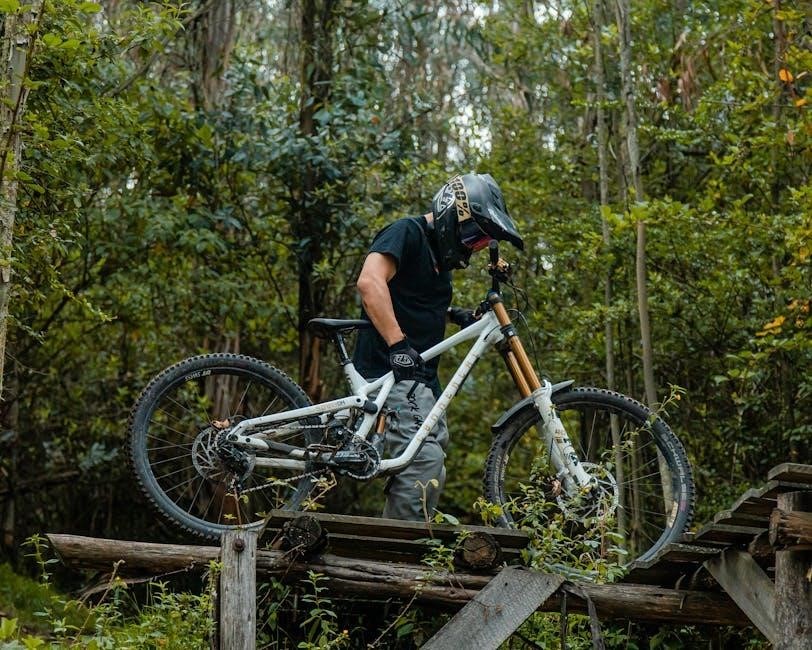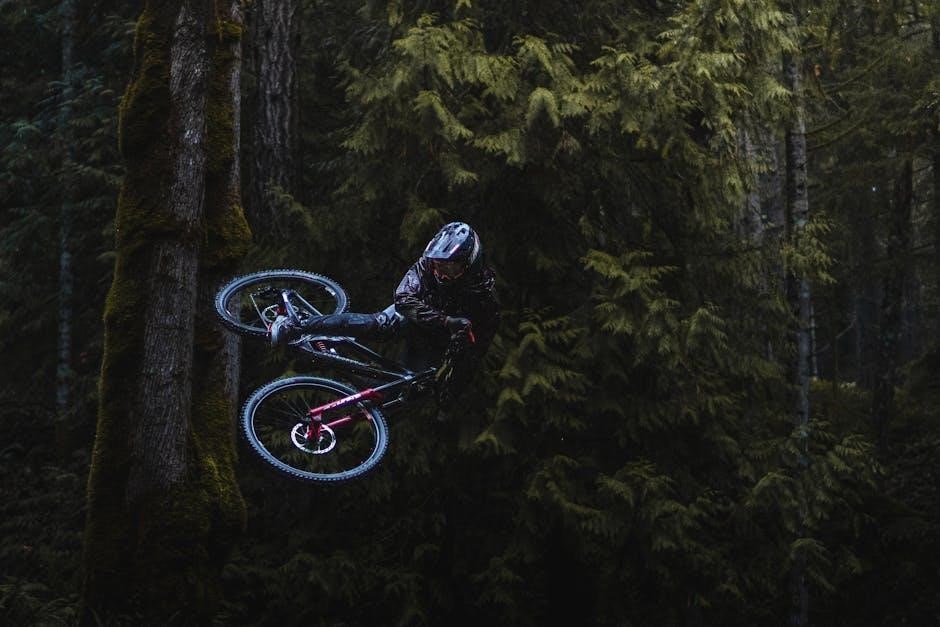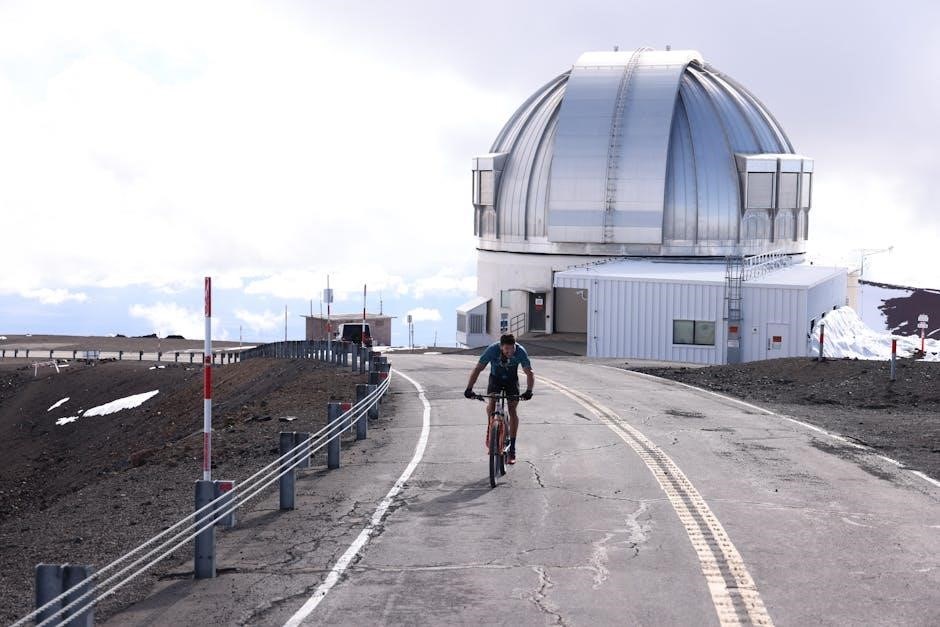mountain bike buying guide
Welcome to our comprehensive guide on selecting the perfect mountain bike for your needs․ Whether you’re a novice or an experienced rider, this guide will help you make an informed decision, ensuring you find the ideal bike for your adventures․
Understanding the Importance of Choosing the Right Mountain Bike
Selecting the right mountain bike is crucial for optimizing performance, comfort, and safety․ The correct bike ensures a more enjoyable riding experience, prevents discomfort or injury, and enhances your ability to tackle various terrains․ A well-chosen bike aligns with your riding style, whether recreational or competitive, and meets your specific needs․ Investing time in understanding your preferences and requirements guarantees a better fit and improved overall satisfaction․ This guide helps you navigate the process, ensuring your mountain bike is tailored to your adventures and aspirations, making every ride more fulfilling and enjoyable․ It’s an investment in your passion for cycling and the outdoors․

Types of Mountain Bikes
Mountain bikes vary widely, catering to different riding styles and terrains․ From hardtails to full-suspension, cross-country to downhill, each type offers unique advantages for specific adventures․
Hardtail vs․ Full-Suspension Bikes: Which is Best for Beginners?
For beginners, hardtail bikes are often the best choice due to their simplicity and affordability․ They feature a front suspension fork but no rear suspension, making them lighter and easier to maintain․ Full-suspension bikes, while offering better comfort and control on rough terrain, are more complex and expensive․ Hardtails provide a great platform for learning fundamental skills like balance and handling․ They are also less prone to mechanical issues, making them ideal for riders who are still developing their skills․ Ultimately, a hardtail bike is a practical and cost-effective option for those new to mountain biking․
Different Mountain Bike Categories: Cross-Country, Trail, Enduro, and Downhill
Mountain bikes are categorized into four main types, each designed for specific riding styles․ Cross-country bikes are lightweight and built for speed on smooth trails․ Trail bikes offer a balance between climbing and descending, making them versatile for varied terrain․ Enduro bikes are designed for challenging, technical rides with steep descents and climbs․ Downhill bikes are heavy-duty, with robust frames and suspension, ideal for high-speed descents on rough trails․ Understanding these categories helps riders choose a bike that matches their preferred terrain and riding style, ensuring optimal performance and enjoyment on the trails․

Key Features to Consider
When selecting a mountain bike, prioritize frame materials, suspension quality, wheel size, and braking systems․ These elements ensure durability, performance, and control on various terrains․ Research thoroughly to make an informed decision that suits your riding style and preferences․

Frame Materials: Aluminum, Carbon Fiber, and Steel
Frame materials significantly impact a mountain bike’s performance, durability, and weight․ Aluminum frames are lightweight, durable, and affordable, making them a popular choice for entry-level to mid-range bikes․ Carbon fiber frames offer exceptional strength-to-weight ratio, ideal for high-performance and competitive riding, though they are more expensive․ Steel frames provide superior comfort and durability, often used in custom or specialty bikes․ Each material has its pros and cons, so consider your riding style, budget, and terrain preferences when choosing the right frame for your mountain bike․
Wheel Size: 27․5″, 29″, and 27․5″+ Options
Wheel size plays a crucial role in a mountain bike’s handling and performance․ The 27․5″ wheels are versatile, offering quick acceleration and maneuverability, ideal for technical trails; The 29″ wheels provide better roll-over capabilities and stability at higher speeds, suitable for cross-country and smoother terrain․ The 27․5″+ option combines the benefits of 27․5″ wheels with a wider tire, enhancing traction and control on loose or uneven surfaces․ Riders should choose based on their terrain preferences and riding style to maximize efficiency and enjoyment․ Each size caters to different needs, ensuring optimal performance across various mountain biking conditions․ Your choice impacts both speed and agility․
Suspension: Front Fork and Rear Shock Specifications
Suspension is a critical component of a mountain bike, enhancing comfort and control by absorbing shock from rough terrain․ A front fork with sufficient travel (e․g․, 100-150mm) is essential for handling drops and bumps․ Rear shocks, found on full-suspension bikes, complement the fork, offering improved stability․ Coil-sprung and air-sprung options are available, with coil shocks providing consistent performance and air shocks allowing adjustable stiffness․ Hardtail bikes feature only a front fork, which is sufficient for smoother trails․ Suspension systems vary by intended use, with longer travel for downhill and shorter for cross-country․ Proper setup ensures optimal performance and rider comfort․
Choosing the Right Size and Fit
Choosing the right size and fit ensures optimal comfort and performance․ Measure standover height and inseam, use size charts, and adjust components like seat height and handlebars for a perfect fit․
How to Measure Your Bike Size for Optimal Comfort
Measuring your bike size involves calculating standover height and inseam․ Stand with your shoes on and measure the distance between your inseam and the bike’s top tube․ Ensure 1-2 inches of clearance for mountain bikes․ Use a size chart specific to the manufacturer, as frames can vary․ Test rides are crucial to confirm fit, allowing adjustments for comfort and efficiency․ Proper sizing enhances control, reduces fatigue, and improves overall riding performance․ Consider your riding style and personal preference when finalizing your bike size for the best experience on the trails․
Adjusting Handlebars, Seat Height, and Other Components for Proper Fit
Proper fit is crucial for comfort and performance․ Start by adjusting the saddle height to allow a slight bend in your knee when the pedal is at its lowest point․ Handlebars should be set to a height that allows a neutral wrist position and comfortable reach․ Stem length can be tweaked for optimal reach and control․ Ensure the saddle is level and positioned to support your sit bones․ Test ride adjustments to fine-tune your setup, prioritizing comfort and efficiency․ Small tweaks can make a big difference in your riding experience, so take the time to dial in your bike’s fit․

Budget and Price Range
Making a budget is crucial when buying a mountain bike․ Prices vary widely, so knowing your budget helps narrow options and find the best bike for the money․
Entry-Level, Mid-Range, and High-End Mountain Bikes
Mountain bikes are categorized into entry-level, mid-range, and high-end based on features and price․ Entry-level bikes are perfect for beginners, offering durability and basic features at an affordable price․ Mid-range bikes provide enhanced performance with better components, suitable for occasional riders․ High-end models boast advanced technology, lightweight frames, and premium suspension systems, ideal for serious enthusiasts and competitive riders․ Each category offers distinct benefits, ensuring there’s a bike for every rider’s skill level and budget․
What to Expect in Different Price Categories
Different price categories for mountain bikes offer varying levels of quality and performance․ Entry-level bikes (under $1,000) are durable with basic components, suitable for casual rides․ Mid-range bikes ($1,000–$3,000) feature improved suspension, brakes, and gearing, ideal for frequent riders․ High-end bikes (over $3,000) offer lightweight frames, advanced suspension, and top-tier components, designed for serious enthusiasts․ Each category balances cost and quality, ensuring riders find a bike that matches their riding style and budget․ Understanding these categories helps narrow down choices, making the selection process more manageable and tailored to individual needs and preferences․
Additional Considerations
Beyond the bike itself, consider accessories like helmets, gloves, and lights․ Regular maintenance is crucial for performance and longevity․ Ensure you have a budget for these extras․
Riding Style: Recreational, Trail, or Competitive
Your riding style significantly influences your mountain bike choice․ Recreational riders prioritize comfort and versatility, often opting for hardtail bikes on smooth trails․ Trail riders seek balance, favoring full-suspension bikes for varied terrain․ Competitive riders demand high-performance bikes with advanced features for speed and precision․ Understanding your style helps narrow down the best bike for your needs, ensuring a more enjoyable and tailored riding experience․ Whether cruising casually or racing downhill, matching your bike to your style enhances performance and satisfaction․ Always consider how and where you’ll ride most frequently․
Accessories and Maintenance: Essential Items for Every Rider
Equipping yourself with the right accessories and maintaining your bike are crucial for a safe and enjoyable riding experience․ A high-quality helmet is non-negotiable, while gloves improve grip and protect hands․ A multi-tool, spare tubes, and a pump or CO2 inflator are essentials for trailside repairs․ Regular maintenance, such as cleaning the chain and checking brakes, ensures optimal performance․ Additional accessories like a water bottle cage and lights can enhance utility․ Investing in these items not only extends your bike’s lifespan but also prepares you for unexpected situations, making every ride more confident and stress-free․ Stay prepared and keep your bike in top shape․
With this guide, you’re ready to make an informed decision․ Choose the right bike, gear up, and embrace the thrill of mountain biking adventures confidently!
Final Tips for Making the Best Purchase Decision
Test ride bikes to ensure comfort and performance․ Prioritize features that match your riding style and terrain․ Set a budget and stick to it, balancing quality and cost․ Consider future upgrades and durability․ Don’t overlook essential accessories like helmets and proper footwear․ Consult with experts or read reviews for insights․ Finally, trust your instincts and choose a bike that excites you for countless adventures ahead!
